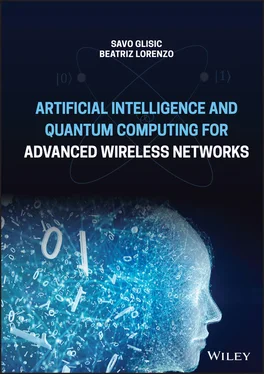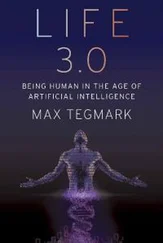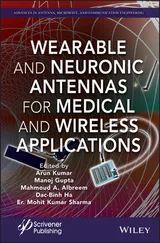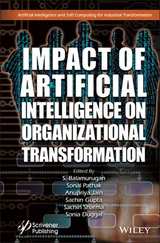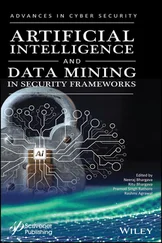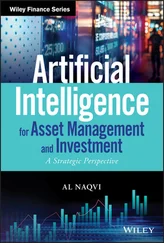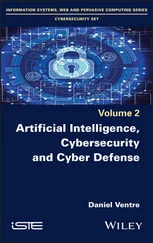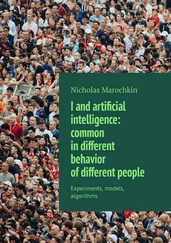Savo G. Glisic - Artificial Intelligence and Quantum Computing for Advanced Wireless Networks
Здесь есть возможность читать онлайн «Savo G. Glisic - Artificial Intelligence and Quantum Computing for Advanced Wireless Networks» — ознакомительный отрывок электронной книги совершенно бесплатно, а после прочтения отрывка купить полную версию. В некоторых случаях можно слушать аудио, скачать через торрент в формате fb2 и присутствует краткое содержание. Жанр: unrecognised, на английском языке. Описание произведения, (предисловие) а так же отзывы посетителей доступны на портале библиотеки ЛибКат.
- Название:Artificial Intelligence and Quantum Computing for Advanced Wireless Networks
- Автор:
- Жанр:
- Год:неизвестен
- ISBN:нет данных
- Рейтинг книги:3 / 5. Голосов: 1
-
Избранное:Добавить в избранное
- Отзывы:
-
Ваша оценка:
- 60
- 1
- 2
- 3
- 4
- 5
Artificial Intelligence and Quantum Computing for Advanced Wireless Networks: краткое содержание, описание и аннотация
Предлагаем к чтению аннотацию, описание, краткое содержание или предисловие (зависит от того, что написал сам автор книги «Artificial Intelligence and Quantum Computing for Advanced Wireless Networks»). Если вы не нашли необходимую информацию о книге — напишите в комментариях, мы постараемся отыскать её.
A practical overview of the implementation of artificial intelligence and quantum computing technology in large-scale communication networks Artificial Intelligence and Quantum Computing for Advanced Wireless Networks
Artificial Intelligence and Quantum Computing for Advanced Wireless Networks
Artificial Intelligence and Quantum Computing for Advanced Wireless Networks — читать онлайн ознакомительный отрывок
Ниже представлен текст книги, разбитый по страницам. Система сохранения места последней прочитанной страницы, позволяет с удобством читать онлайн бесплатно книгу «Artificial Intelligence and Quantum Computing for Advanced Wireless Networks», без необходимости каждый раз заново искать на чём Вы остановились. Поставьте закладку, и сможете в любой момент перейти на страницу, на которой закончили чтение.
Интервал:
Закладка:
Chapter 9(Quantum Channel Information Theory): Quantum information processing exploits the quantum nature of information. It offers fundamentally new solutions in the field of computer science and extends the possibilities to a level that cannot be imagined in classical communication systems. For quantum communication channels, many new capacity definitions were developed in analogy with their classical counterparts. A quantum channel can be used to achieve classical information transmission or to deliver quantum information, such as quantum entanglement. In this chapter, we review the properties of the quantum communication channel, the various capacity measures, and the fundamental differences between the classical and quantum channels [37–43]. Specifically, we will discuss the privacy and performance gains of quantum channels, the quantum channel map, the formal model, quantum channel capacity, classical capacities of a quantum channel, the quantum capacity of a quantum channel, quantum channel maps, and capacities and practical implementations of quantum channels.
Chapter 10(Quantum Error Correction): The challenge in creating quantum error correction codes lies in finding commuting sets of stabilizers that enable errors to be detected without disturbing the encoded information. Finding such sets is nontrivial, and special code constructions are required to find stabilizers with the desired properties. We will start this section by discussing how a code can be constructed by concatenating two smaller codes. Other constructions include methods for repurposing classical codes to obtain commuting stabilizer checks [44–47]. Here, we will outline a construction known as the surface code [48, 49]. The realization of a surface code logical qubit is a key goal for many quantum computing hardware efforts [50–54]. The codes belong to a broader family of so‐called topological codes [55]. In this framework, within this chapter we will discuss stabilizer codes, surface codes, the rotated lattice, fault‐tolerant gates, fault tolerance, theoretical framework, classical error correction, and the theory of quantum error correction in addition to some auxiliary material on binary fields and discrete vector spaces, and noise physics.
Chapter 11(Quantum Search Algorithms): The appetite for faster, more reliable, greener, and more secure communications continues to grow. The state‐of‐the‐art methods conceived for achieving the performance targets of the associated processes may be accompanied by an increase in computational complexity. Alternatively, degraded performance may have to be accepted due to the lack of jointly optimized system components. In this chapter, we investigate the employment of quantum computing for solving problems in wireless communication systems. By exploiting the inherent parallelism of quantum computing, quantum algorithms may be invoked for approaching the optimal performance of classical wireless processes, despite their reduced number of CFEs cost-function evaluations. In Chapter 8, we have already discussed the basics of quantum computing using linear algebra, before presenting here the operation of the major quantum algorithms that have been proposed in the literature for improving wireless communications systems. Furthermore, in the following chapters, we will investigate a number of optimization problems encountered both in the physical and network layer of wireless communications, while comparing their classical and quantum‐assisted solutions. More specifically, in this chapter we will discuss the following: quantum search algorithms (QSAs) for wireless communications such as the Deutsch algorithm, the Deutsch–Jozsa algorithm, Simon’s algorithm, Shor’s algorithm, the quantum phase estimation algorithm, Grover’s QSA, the Boyer–Brassard–Høyer–Tapp QSA, the Dürr–Høyer QSA, quantum counting algorithm, quantum heuristic algorithm, quantum genetic algorithm, Harrow–Hassidim–Lloyd algorithm, quantum mean algorithm, and quantum‐weighted sum algorithm.
Chapter 12(Quantum Machine Learning): In this chapter, we provide a brief description of quantum machine learning (QML) and its correlation with AI. We will see how the quantum counterpart of ML is much faster and more efficient than classical ML. Training the machine to learn from the algorithms implemented to handle data is the core of ML. This field of computer science and statistics employs AI and computational statistics. The classical ML method, through its subsets of deep learning (supervised and unsupervised), helps to classify images, recognize patterns and speech, handle big data, and many more. Thus, classical ML has received a lot of attention and investments from the industry. Nowadays, due to the huge quantities of data with which we deal every day, new approaches are needed to automatically manage, organize, and classify these data. Classical ML, which is a flexible and adaptable procedure, can recognize patterns efficiently, but some of these problems cannot be efficiently solved by these algorithms. Companies engaged in big databases management are aware of these limitations, and are very interested in new approaches to accomplish this. They have found one of these approaches in quantum ML. However, the interest in implementing these techniques through QC is what paves the way for quantum ML. QML [56–59] aims to implement ML algorithms in quantum systems by using quantum properties such as superposition and entanglement to solve these problems efficiently. This gives QML an edge over the classical ML technique in terms of speed of functioning and data handling. In the QML techniques, we develop quantum algorithms to operate classical algorithms using a quantum computer. Thus, data can be classified, sorted, and analyzed using the quantum algorithms of supervised and unsupervised learning methods. These methods are again implemented through models of a quantum neural network or support vector machine. This is the point where we merge the algorithms discussed in Parts I and II of this book. In particular, we will discuss QML algorithms, quantum neural network preliminaries, quantum, classifiers with ML: near‐term solutions, the circuit‐centric quantum classifier, training, gradients of parameterized quantum gates, classification with quantum neural networks, representation, learning, the quantum decision tree classifier, and the model of the classifier in addition to some auxiliary material on matrix exponential .
Chapter 13(Quantum Computing Optimization): Convexity naturally arises in many segments of quantum information theory; the sets of possible preparations, processes, and measurements for quantum systems are all convex sets. Many important quantities in quantum information are defined in terms of a convex optimization problem, such as quantifying entanglement [60, 61]. Since the set of separable or unentangled states is convex, a measure of entanglement may be defined for entangled states outside of this set, given a suitable “distance” measure, such as the minimum distance to a state inside. Perhaps the most well known of these quantities is the relative entropy of entanglement. In addition, in the chapter we discuss a number of optimization algorithms including optimization for hybrid quantum‐classical algorithms, the quantum approximate optimization algorithm (QAOA), convex optimization in quantum information theory, relative entropy of entanglement, quantum algorithms for combinatorial optimization problems, QC for linear systems of equations, a design example (QC for multiple regression), and a quantum algorithm for systems of nonlinear differential equations.
Chapter 14(Quantum Decision Theory): The classical decision‐making process is mostly based on expected utility theory, and its performance significantly degrades in scenarios involving risk and uncertainty [62]. In most of the classical decision‐making processes, the possibility of making correct predictions can be strongly affected by the nature of the surrounding environment such as the unknown stochastic or varying environment. Furthermore, in scenarios having incomplete or partially reliable information or incomplete preference relations, any prediction is likely to be just partial and qualitative. To address this, quantum decision theory (QDT) seems to be a promising approach and has been already investigated in the existing literature [62, 63]. Also, the process of representing all steps of a decision process mathematically in order to allow quantitative prediction is significant not only for the decision theory but also for developing artificial quantum intelligence, which can work only for the operations defined in mathematical terms [64].
Читать дальшеИнтервал:
Закладка:
Похожие книги на «Artificial Intelligence and Quantum Computing for Advanced Wireless Networks»
Представляем Вашему вниманию похожие книги на «Artificial Intelligence and Quantum Computing for Advanced Wireless Networks» списком для выбора. Мы отобрали схожую по названию и смыслу литературу в надежде предоставить читателям больше вариантов отыскать новые, интересные, ещё непрочитанные произведения.
Обсуждение, отзывы о книге «Artificial Intelligence and Quantum Computing for Advanced Wireless Networks» и просто собственные мнения читателей. Оставьте ваши комментарии, напишите, что Вы думаете о произведении, его смысле или главных героях. Укажите что конкретно понравилось, а что нет, и почему Вы так считаете.
